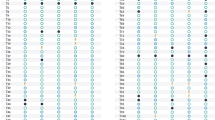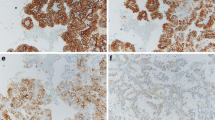Abstract
This study investigated the frequency of allelic imbalance (AI) in particular loci in conventional renal cell carcinoma tissue and premalignant lesions of the kidney. DNA from the tumor tissue, premalignant lesions and normal kidney tissue of radical nephrectomy specimens from 33 patients was obtained. It was amplified with a set of eight microsatellite markers, which are located on chromosomes 2, 3, 5, 8, 9, 11, 16, 17. AI in DNA samples was determined by analysis of the alteration in (CA)n repeats. The rates of AI in tumor tissue were found to be between 22.2% and 53.3% and in premalignant lesions between 11.1% and 40.0%. Premalignant lesions and tumor tissues in conventional renal cell carcinoma have the same genotypic changes in 50.0–87.8% (informative cases). These results suggest that the progressive accumulation of AI in areas of premalignant lesions may contribute to the development of renal cell carcinoma, representing an important molecular event in the multistep renal carcinogenesis cascade.


Similar content being viewed by others
References
Cahill DP, Kinzler KW, Vogelstein B, Lengauer C (1999) Genetic instability and Darwinian selection in tumors. Trends Cell Biol 9:M57-M60
Diakoumis E, Sourvinos G, Kiaris H, Delakos D, Cranidis A, Spandidos DA (1998) Genetic instability in renal cell carcinoma. Eur Urol 33:227
Dib C, Faure S, Fizames C, Samson D, Drout N, Vignal A, Millasseau P, Marc S, Hazan J, Seboun E, Lathrop M, Gyapay G, Morissette J, Weissenbach J (1996) The Genethon human genetic linkage map. Nature 380:A-21, A-25, A-63, A-65, A-79, A-101, A-105
Erdem H, Pehlivan S, Topaloğlu H, Togan I, Ozguc M (1997) Allele distribution of D5S125, MAP1B5′ and D5S679 microsatellite markers in turkish spinal muscular atrophy families. Turk J Pediatr 39:447
Fuhrman S, Lasky L, Lumas C (1982) Prognostic significance of morphologic parameters in renal cell carcinoma. Am J Pathol 6:655
Goelz SE (1985) Purification of DNA from formaldehyde fixed and paraffin embedded human tissue. Biochem Biophys Res Commun 130:118
Ingvarsson S, Finndottir V, Sigurdsson A, Geirsson G (2000) Population studies and validation of paternity determinants by six microsatellite loci. Forensic Sci 45:692
Jiang F, Desper R, Papadimitriou CH, Schaffer AA, Kallioniemi OP, Richter J, Schraml P, Sauter G, Mihatsch MJ, Moch H (2000) Construction of evolutionary tree models for renal cell carcinoma from comparative genomic hybridization data. Cancer Res 60:6503
Kirkali Z, Lekili M (2003) Renal cell carcinoma: new prognostic factors? Curr Opin Urol 13:433
Leung WK, Kim JJ, Kim JG, Graham DY, Sepulveda AR (2000) Microsatellite instability in gastric intestinal metaplasia in patients with and without gastric cancer. Am J Pathol 156:537
Mourad WA, Nestok BR, Saleh GY, Solez K, Power RF, Jewell LD (1994) Dysplastic tubular epithelium in “normal” kidney associated with renal cell carcinoma. Am J Surg Pathol 18:1117
Sobin LH, Wittekind CH (1997) For the International Union Against Cancer (IUCC); TNM Classification of Malignant Tumors, 5th edn. Wiley-Liss, New York
Steiner G, Sidransky D (1996) Molecular differential diagnosis of renal cell carcinoma: from microscopes to microsatellites. Am J Pathol 149:2081
Störkel S, Eble JN, Adlakha K, Amin M, Blute ML, Bostwick DG, Darson M, Delahunt B, Iczkowski K (1997) Classification of renal cell carcinoma. Workgroup No I. Cancer 80:987
Van Dekken H, Alers JC, Riegman PHJ, Rosenberg C, Tilanus HW, Vissers K (2001) Molecular cytogenetic evaluation of gastric cardia adenocarcinoma and precursor lesions. Am J Pathol 158:1961
Van Poppel H, Nilsson S, Algaba F, Bergerheim U, DalCin P, Fleming S, Hellsten S, Kirkali Z, Klotz L, Lindblad P, Ljungberg B, Mulders P, Roskams T, Ross RK, Walker C, Wersall D (2000) Precancerous lesions in the kidney. Scand J Urol Nephrol Suppl 34:136
Von Knobloch R, Hegele A, Brandt H, Varga Z, Wille S, Kalble T, Heidenreich A, Hoffmann R (2002) High frequency of serum DNA alterations in renal cell carcinoma detected by fluorescent microsatellite analysis. Int J Cancer 98:889
Weber RG, Scheer M, Born IA, Joos S, Cobbers JM, Hofele C, Reifenberger G, Zoller JE, Lichter P (1998) Recurrent chromosomal imbalances detected in biopsy material from oral premalignant and malignant lesions by combined tissue microdissection, universal DNA amplification, and comparative genomic hybridization. Am J Pathol 153:295
Wild P, Knuechel R, Dietmaier W, Hofstaedter F, Hartmann A (2000) Laser microdissection and microsatellite analyses of breast cancer reveal a high degree of tumor heterogeneity. Pathobiology 68:180
Yörükoğlu K, Aktaş S, Mungan MU, Kirkali Z (1999) Tubular dysplasia and carcinoma in situ: precursors of renal cell carcinoma. Urology 53:684
Acknowledgement
This work was supported by the Turkish Scientific and Technical Research Council (TUBITAK) Research Fund no:SBAG-1940 and Ege University Research Fund no: 98/BIL/020.
Author information
Authors and Affiliations
Corresponding author
Rights and permissions
About this article
Cite this article
Pehlivan, S., Koyuncuoglu, M., Pehlivan, M. et al. Premalignant lesions of the kidney share the same genetics changes as conventional renal cell carcinoma. World J Urol 22, 120–123 (2004). https://doi.org/10.1007/s00345-003-0384-6
Received:
Accepted:
Published:
Issue Date:
DOI: https://doi.org/10.1007/s00345-003-0384-6




